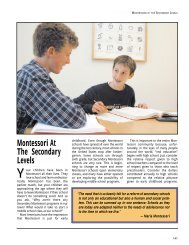Tim Seldin & Paul Epstein Ph.D. An Education for Life
Tim Seldin & Paul Epstein Ph.D. An Education for Life
Tim Seldin & Paul Epstein Ph.D. An Education for Life
You also want an ePaper? Increase the reach of your titles
YUMPU automatically turns print PDFs into web optimized ePapers that Google loves.
(Right) Teaching Peace<br />
The Peace Table plays an<br />
important role in Montessori<br />
classrooms. Two children<br />
having a disagreement will<br />
normally decide to retreat to<br />
the Peace Table to solve their<br />
problem. Sometimes, children<br />
may not remember, and the<br />
suggestion might come from the<br />
teacher. When classmates<br />
observe an ongoing disagreement,<br />
somebody might bring<br />
them a peace rose with the<br />
reminder to solve their problem<br />
at the Peace Table.<br />
A GUIDED TOUR OF MONTESSORI CLASSROOMS — LESSONS IN GRACE, COURTESY & COMMUNITY SERVICE<br />
Once arrived at the table, the<br />
child who feels wronged places<br />
her hand on the table, indicating<br />
that she wants to have her<br />
say without interruption. The<br />
other hand she places on her<br />
heart, indicating that she speaks the truth, from the heart. She then<br />
looks the other in the eye, speaks her name, “Lisa,” and proceeds to<br />
state how she feels, “Lisa, I feel very angry ...” and continues to state<br />
why she feels that way, “ ... because you didn’t let me play with you<br />
and Lily!” She states how she wants to resolve the conflict: “<strong>An</strong>d I don’t<br />
want you to do that ever again if you want to be my friend!” Now that<br />
she has stated her case and opened the door <strong>for</strong> further discussion, she<br />
withdraws her hand from the table and from her heart and gives Lisa<br />
a chance to respond.<br />
Lisa proceeds that same way. She places her hands on the table and<br />
her heart, looks Eleanor in the eye, and responds:<br />
“Eleanor, I feel unhappy that you are angry, I did not mean to hurt<br />
your feelings. However, Lily is a good friend of mine also, and the<br />
game we played can be played by only two participants. Had I been<br />
playing it with you, nobody else could have joined us either. So, you<br />
see, it’s just one of those things. I want to remain your friend.”<br />
With that, Lisa is finished and withdraws her hands. Now it is<br />
Eleanor’s turn to agree or disagree. In any case, they continue the dialogue<br />
until they reach some kind of agreement, even if that means that<br />
they disagree. At least they are talking, without yelling, screaming, and<br />
blaming. They want to solve the problem. When they have reached an<br />
agreement, they ring the bell to let the others know. In case they cannot<br />
come to a positive conclusion, they may ask <strong>for</strong> a mediator. This<br />
may be one of the older children, who has been trained to be<br />
impartial and to listen well.<br />
However, if the problem or conflict is too involved, then one of<br />
them may ask <strong>for</strong> a “pow-wow.” During a “pow-wow,” the entire<br />
class, or a large part of the class sits in a circle, listens to first<br />
one, then the other person’s side of the story. The class members<br />
contribute what they can, either as facts of what they have seen<br />
or heard, as ethics (right and wrong), or in perspective to class<br />
rules upon which all have agreed previously. It is wise <strong>for</strong> the<br />
teacher to observe and monitor the entire process from the sidelines.<br />
The core experience<br />
the students<br />
gain from these<br />
procedures is that<br />
it is necessary to<br />
solve disturbances<br />
honestly and with<br />
good will to<br />
maintain a harmonious<br />
and<br />
cooperative<br />
atmosphere in the<br />
community.<br />
63




